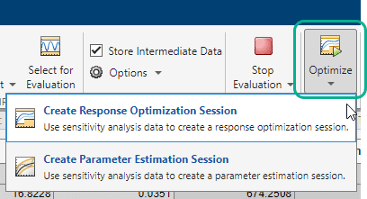Use Sensitivity Analysis to Configure Estimation and Optimization
After you use sensitivity analysis to identify the most relevant parameters for optimization (see Identify Key Parameters for Estimation (GUI)), you can use those results to configure parameter estimation or response optimization.
You can use sensitivity analysis to evaluate how the parameters of a Simulink® model influence the model output or model design requirements. You first generate samples of the parameters, and then define a cost function by creating a design requirement on the model signals. For more information see, Generate Parameter Samples for Sensitivity Analysis, Specify Time-Domain Requirements, and Specify Frequency-Domain Requirements. You then evaluate the requirement (cost function) for each sample. You can use the evaluated results to configure parameter estimation or response optimization in the following ways:
Analyze the relationship between the parameters and the evaluated requirement values, and rank parameters in order of influence. For more information, see Analyze Relation Between Parameters and Design Requirements. You can then choose to estimate or optimize the more influential parameters.
Obtain initial guesses for parameter values for estimation or optimization.
After you evaluate the requirements in the Sensitivity Analyzer, the evaluated requirement (cost function value) and the corresponding parameter values are displayed in the Evaluation Result table of the app. A new variable,
EvalResult, with this information is created in the Results area of the app.For example, open the Simulink model.
The table below lists the evaluated signal matching requirement and corresponding values for the parametersopenExample("sdoVOR")Gain,Delay,Tc, andTpof the model.
To extract parameter values to use as an initial guess during estimation or optimization:
Sort the evaluated cost function values in ascending order by clicking the evaluated requirement column.

To choose the parameter values that minimize the cost function, right-click corresponding row, and select Extract Parameter Values.

A new variable,
ParamValues, is created in the Results area of the app.
When exporting to a Parameter Estimator or Response Optimizer app session, choose this variable to specify the initial guess for parameters.
To test the robustness of your design during optimization in the Response Optimizer app, specify the values for uncertain parameters. For more information, see Optimizing Parameters for Robustness.
You can specify the values for uncertain parameters using all the parameter values in
EvalResults. You can also choose a subset of the parameter values:Select the relevant rows of parameter values in the Evaluation Result table of the app.

Right-click, and select Create new evaluation result. A new variable is created in the Results area of the app.

When exporting to a Response Optimizer app session, choose this variable to specify the uncertain variables.
Export Sensitivity Analysis Results
You can export results from Sensitivity Analyzer to the Parameter Estimator and Response Optimizer apps. To do so, in the Sensitivity Analyzer, click Optimize. In the drop-down menu, choose the app to export to.

Alternatively, if you have an open Parameter Estimator or Response Optimizer session, in these apps, click Sensitivity Analysis. In the drop-down menu, choose Import from Open Session or Import from Session file. The latter option loads results from a previously saved Sensitivity Analyzer session.

Note
Only signal matching requirements are exported from Sensitivity Analysis to a Parameter Estimator session. In the Parameter Estimator, they are referred to as experiments.
Only requirements other than signal matching requirements are exported from Sensitivity Analysis to a Response Optimizer session.